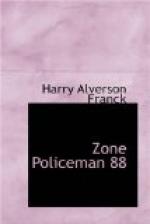So I pushed on, halting at many huts to make covert inquiries. It was a joyous, brilliant day overhead. Down in the dense, rampant, singing jungle I sweated profusely—and enjoyed it. Choking for a drink in a hutless section, I took one of the crooked, tunnel-like trails to the left in the direction of the Chagres. But it squirmed off through thick jungle, through banana groves and untended pineapple gardens to come out at last at an astonished hut on a knoll, from which was not to be seen a sign of the river. I crawled through another struggling side-trail further on and this time reached the stream, but at a bank too sheer and bush-matted to descend. The third attempt brought me to where the river made a graceful bend at my feet and I descended an abrupt jungle bank to drink and stroll a bit along the stony shore; then plunged in for a swim. It was just the right temperature, with dense jungle banks on either side like great green unscalable walls, the water clear and a bit over waist deep in the middle of the stream. Now and then around the one or the other bend came a cayuca, the native dug-out made of the hollowed trunk of a tree, usually the cedro—though to a jungle native any tree is a “cedro” if he does not happen to think of its right name. Twenty to thirty feet long, sometimes piled high with vegetables, sometimes with several natives seated Indian file in the bottom, the gunwales a bare two or three inches above the water, they needed nice management, especially in the rapids below Cruces. The locomotive power, generally naked to the waist, stood up in the craft and climbed his polanca, or long pike pole, hand over hand, every naked brown muscle in play, moving in perfect rhythm and apparent ease even up-stream against the powerful current.
Soon after Chagres and trail parted company, the former to wind on up through the jungle hills to its birthplace in the land of Darien and wild Indians, the latter to strike for the Pacific. Over a mildly rough country it led, down into tangled ravines, up over dense forested hillocks where the jungle had been fought back by Uncle Sam and on the brows of which I halted to drink of the fresh breeze sweeping across from the Atlantic. All this time not a suggestion of anything Greek, though I managed by some simple strategy to cast a sweeping glance into every hovel along the way.
Then came the real Cruces trail—the rest only follows the general direction. I fell upon it unexpectedly. It is still there as it was when the Peruvian viceroys and their glittering trains clattered along it, surprisingly well preserved; a cobbled way some three feet wide of that rough and bumpy variety the Spaniard even to-day fancies a real road, broken in places but still well marked, leading away southward through the wilderness.




